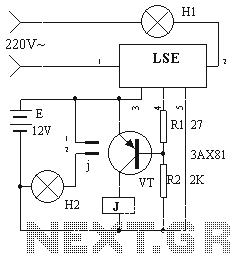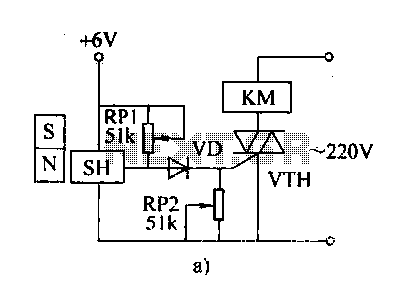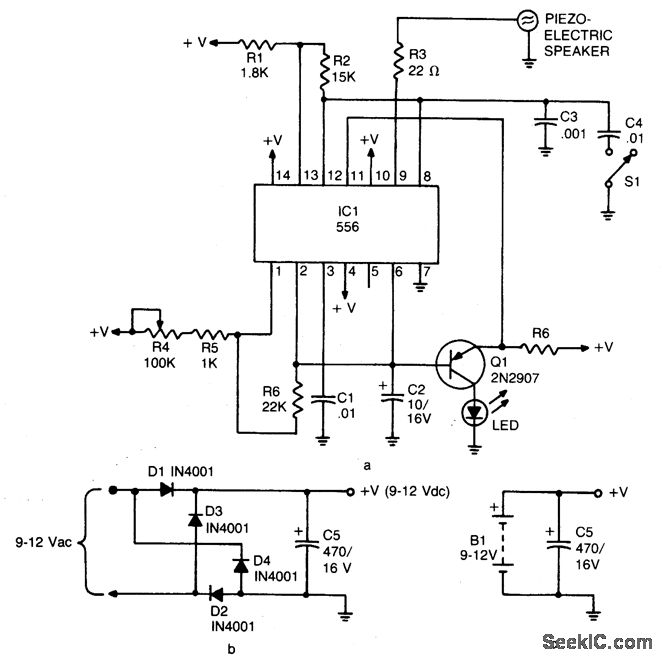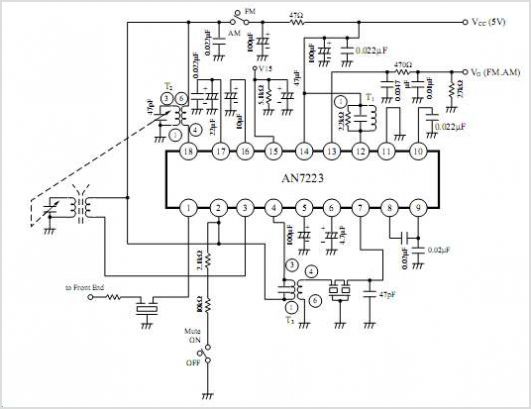
Electronic mosquito repeller circuit diagram
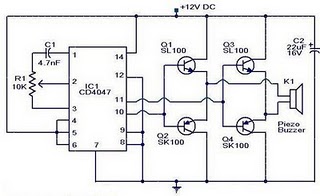
The circuit operates on the principle that insects, such as mosquitoes, can be repelled using sound frequencies in the ultrasonic range (above 20 kHz). It utilizes a Phase-Locked Loop (PLL) integrated circuit, specifically the CMOS 4047, configured as an oscillator functioning at 22 kHz. To amplify the sound, a complementary symmetry amplifier composed of four transistors is employed. The piezo buzzer then converts the amplified output into ultrasonic sound, which is perceptible to the insects.
The circuit design begins with the CMOS 4047 IC, which is configured to generate a stable frequency output of 22 kHz. This frequency is chosen specifically because it lies within the ultrasonic range, which is inaudible to humans but can effectively disturb and repel mosquitoes and other insects. The PLL configuration allows for precise control of the oscillation frequency, ensuring consistent performance.
The output from the CMOS 4047 is then fed into a complementary symmetry amplifier. This amplifier consists of four transistors arranged in a configuration that enhances the output signal's amplitude. The complementary symmetry design allows for efficient amplification while minimizing distortion, which is crucial for maintaining the integrity of the ultrasonic signal.
Finally, the amplified signal is directed to a piezo buzzer. The piezo buzzer is an essential component, as it converts the electrical signal into mechanical vibrations that produce ultrasonic sound waves. These sound waves are emitted into the environment, creating an area that is less hospitable to mosquitoes and similar pests.
The overall circuit is relatively simple yet effective, making it suitable for various applications in pest control. Its compact design allows for easy integration into portable devices, and the use of common electronic components ensures that it can be built at a low cost. Careful consideration should be given to the power supply requirements and the housing of the circuit to optimize its performance and durability in outdoor conditions.The circuit is based on the theory that insects like mosquito can be repelled by using sound frequencies in the ultrasonic (above 20KHz) range. The circuit is nothing but a PLL IC CMOS 4047 wired as an oscillator working at 22KHz. A complementary symmetry amplifier consisting of four transistor is used to amplify the sound. The piezo buzzer converts the output of amplifier to ultrasonic sound that can be heard by the insects. 🔗 External reference
The circuit design begins with the CMOS 4047 IC, which is configured to generate a stable frequency output of 22 kHz. This frequency is chosen specifically because it lies within the ultrasonic range, which is inaudible to humans but can effectively disturb and repel mosquitoes and other insects. The PLL configuration allows for precise control of the oscillation frequency, ensuring consistent performance.
The output from the CMOS 4047 is then fed into a complementary symmetry amplifier. This amplifier consists of four transistors arranged in a configuration that enhances the output signal's amplitude. The complementary symmetry design allows for efficient amplification while minimizing distortion, which is crucial for maintaining the integrity of the ultrasonic signal.
Finally, the amplified signal is directed to a piezo buzzer. The piezo buzzer is an essential component, as it converts the electrical signal into mechanical vibrations that produce ultrasonic sound waves. These sound waves are emitted into the environment, creating an area that is less hospitable to mosquitoes and similar pests.
The overall circuit is relatively simple yet effective, making it suitable for various applications in pest control. Its compact design allows for easy integration into portable devices, and the use of common electronic components ensures that it can be built at a low cost. Careful consideration should be given to the power supply requirements and the housing of the circuit to optimize its performance and durability in outdoor conditions.The circuit is based on the theory that insects like mosquito can be repelled by using sound frequencies in the ultrasonic (above 20KHz) range. The circuit is nothing but a PLL IC CMOS 4047 wired as an oscillator working at 22KHz. A complementary symmetry amplifier consisting of four transistor is used to amplify the sound. The piezo buzzer converts the output of amplifier to ultrasonic sound that can be heard by the insects. 🔗 External reference
